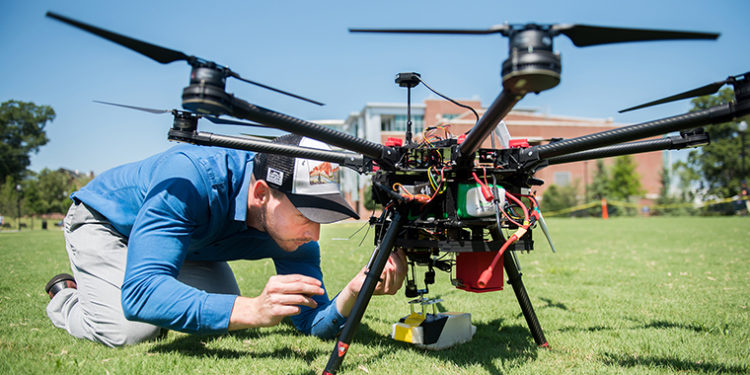 Filtering Out the Noise, In Search of a Signal
Filtering Out the Noise, In Search of a Signal
The Global Positioning System (GPS) is a mainstay of modern life. We use it every day, but most of us have little understanding of how it works – or its vulnerabilities. Yet as technology advances, GPS signal vulnerability is a growing problem: Intentional or inadvertent satellite interference can render GPS useless by compromising signal communication.
That’s changing, thanks to two experts at the University of Tennessee at Chattanooga (UTC) College of Engineering and Computer Science. Senior Research Associate Zachary Ruble and Dean Daniel Pack invented new technology to extract genuine GPS signals amid incoming interference.

It all began with the Department of Defense’s interest in protecting drone operations from tipped-off enemies. U.S. drones’ GPS signals are increasingly under threat of interference, particularly through spoofing attacks, where false signals interfere to confuse the drone about its true location. Given their respective backgrounds and positions in UTC’s Unmanned Systems Laboratory, Zach and Daniel made ideal partners for the task. Zach specializes in creating cooperative and communicative robotics systems; Daniel’s expertise is in sensor-based intelligent control, especially cooperative unmanned aerial vehicles, commonly known as UAVs or drones.
Their first step was simple: Explore how GPS actually works.
The short answer is that the United States government has a satellite constellation comprised of 24 satellites orbiting the earth. This number ensures that at least four satellites are in the line-of-sight of every location on Earth. Each of these 24 satellites sends out a unique code, and GPS devices synchronize with four or more satellites simultaneously, using trilateration to analyze the information and calculate a specific location on earth surface based on the time it takes to receive signals from each satellite in view.
Working with the University of Texas at San Antonio, Zach and Daniel focused on ways to lower channel interference on a software-defined radio. Together they developed and implemented a new algorithm to mitigate this interference, and then turned their attention to researching methods to improve it. One day, while studying incoming satellite signals, Zach noticed a pattern in the signal histogram. His realization sparked an entirely new idea.

Together the partners created a new algorithm using a completely different approach to eliminating interference on incoming signals. “Our innovation cuts the complexity behind extracting true GPS signal out of interference; it’s faster, more efficient, and requires much less processing capability compared to conventional methods of signal extraction,” comments Zach.
With UTRF’s guidance, the researchers obtained a provisional patent for the technology and are in the process of vetting potential partners. This novel technology has enormous implications not only for the military but for commercial application as well. Search-and-rescue teams, natural disaster clean up, and law enforcement missions all depend on GPS accuracy and dependability, and the list continues.
“As the evolution of technology uncovers new threats, UTRF gladly partners with researchers like Zach and Daniel who dedicate their time and talents to innovative solutions that increase our quality of life,” remarks UTRF Licensing Associate Nghia Chiem.